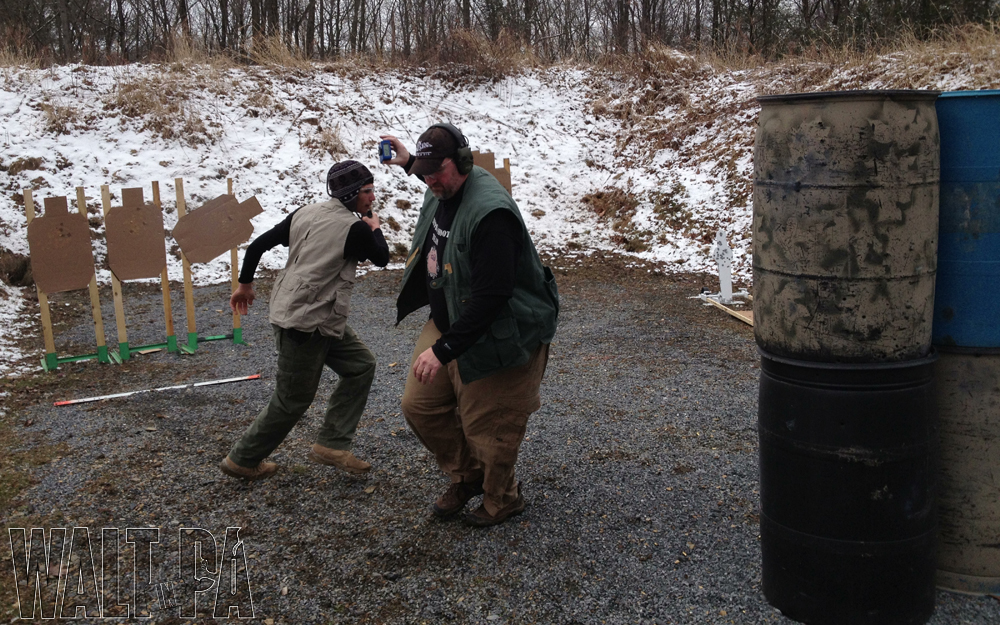
I like to think of myself as one of the few USPSA Shooters that can discuss IDPA without a negative bias towards my sport of choice. I am a USPSA Shooter first and an IDPA Shooter second. I tend to shoot IDPA for fun and to practice with my carry gun. This approach allows me to enjoy the sport for what it is without getting too caught up in the USPSA vs IDPA debate.
Much like I am competitive in USPSA and tend to shoot IDPA for fun, I have friends that do just the opposite. One such friend is Kerry Woods from the AngryPig Shooting Team . Kerry shoots the occasional USPSA Match but has become a fixture at area IDPA Matches. When Kerry talks about IDPA, you can see it in his face, he is passionate about the sport.
. Kerry shoots the occasional USPSA Match but has become a fixture at area IDPA Matches. When Kerry talks about IDPA, you can see it in his face, he is passionate about the sport.
Even though I’m not a big IDPA Shooter, I got caught up in the hype of the new IDPA Rulebook. I enjoyed the drama that surrounded all of these mysterious changes and what they might mean for the sport. Who would benefit most, the gamers or the traditionalists? As the release date grew near, I wondered how people such as Kerry woud react to changes that could dramatically affect how the game was played.
As the rulebook unveiling grew closer and closer, I saw that Joyce Wilson, Executive Director of IDPA, was making the rounds on Podcasts to spread the word. I listened to the Shooting USA Podcast and was intrigued. I learned of a couple rules we could expect to see and pretty much assumed that each podcast thereafter would be more or less the same. Boy was I wrong in that regard, the When The Balloon Goes Up Podcast
and was intrigued. I learned of a couple rules we could expect to see and pretty much assumed that each podcast thereafter would be more or less the same. Boy was I wrong in that regard, the When The Balloon Goes Up Podcast was loaded with information and made me all the more interested in getting my hands on the new rulebook.
was loaded with information and made me all the more interested in getting my hands on the new rulebook.
When the new IDPA Rulebook was finally released to the public, I was underwhelmed. Leading up to the release we were told that Safety Officers would be making less judgement calls. This would allow matches across the county to become more consistent. There were a few new rules that seemed to do just the opposite.
was finally released to the public, I was underwhelmed. Leading up to the release we were told that Safety Officers would be making less judgement calls. This would allow matches across the county to become more consistent. There were a few new rules that seemed to do just the opposite.
It didn’t take long for concerns to begin spreading throughout my Facebook Timeline. The most diverse came from Kerry as he stepped through a variety of concerns and what they meant for everyone involved in the sport. Kerry has done a wonderful job outlining those concerns which have been included below.
How is this the Result?
Written By Kerry WoodsJust to be clear I am not a USPSA shooter taking advantage of the new RB to trash IDPA. I am an IDPA shooter. I shoot 3-4 matches a month with my two teenage sons. I immensely enjoy this game and am a huge advocate for it, there is rarely a month that goes by that I am not bringing 1 or 2 new shooter to a match. I do shoot USPSA occasionally, but being an old fat guy IDPA is more my speed, and it suits my mindset much better than USPSA. I am not advocating one game over the other, just setting up what my perspective is in writing this.
First off I appreciated the fact that there was a significant volunteer effort in developing the new RB and I am sure that the TT members worked diligently during this process. However that does not change the fact that IDPA is a for profit organization that every customer pays for the use of their product. Including each host club, which becomes a registered IDPA club with the expectation that the product produced by IDPA will attract shooters and provide a revenue stream for their club (well at least not result in a loss).
What is IDPA’s product?
The Rule Book.
It is the intellectual property that IDPA sells to every paying customer, and defends when local clubs run matches, using this intellectual property without becoming a registered club.
The customers of IDPA over the years, have identified several issues with the current product, so IDPA set out to address those issues. 18 months, and many man hours later that revised product is falling very short of at least a vocal subset, of the customer base’s expectations.
The new RB does address some issues that were essential unenforceable elements of the old RB, like the “round dumping” rule. As well as the ability to initiate a reload in the open if a shooter goes to slide lock in the open, the addition of the 180* rule and providing a non-subjective definition of what is cover.
However the things that are wrong in the new RB are very wrong. Each rule in the new RB was supposed to be vetted by asking the following 4 questions:
- What is the purpose or history of the rule?
- Is it still valid?
- Does it support the founder’s principles or values?
- Does it require the Safety Officer to make a judgment call?
The assumption is that if you could not answer “yes” to questions 2&3, “no” to question 4 and somehow determine the application of question 1, then the rule would not make it into the new RB. However the result of this process, where new rules were added, seems to in many cases go directly against the vetting requirements. Let’s take look at just a few:
S8. If the muzzle of the shooter’s firearm points further up range than a “Muzzle Safe Point” the shooter will be Disqualified from the match. The shooter will be given the command “Stop.” The shooter will stop immediately, place the trigger finger straight alongside the frame of the firearm, and wait for further instructions from the SO.
If the muzzle of the shooter’s firearm points near to a muzzle safe point but not past, the “Muzzle” command will be given. The first occurrence in a match will be a warning. The second occurrence in a single match will result in a Failure To Do Right (FTDR) penalty. The third occurrence in a single match will result in a Disqualification.
Let’s apply the 4 questions to this rule:
Q1 – No Application
Q2 – No Application
Q3 – No Application
Q4 – YESBased on the YES answer to Q4 this rule should not have made it through the vetting process – the shooter is punished for not breaking a rule
S14. The SO will physically stop a shooter when possible, most likely by grabbing his/her arm, if the shooter is about to do something unsafe. If the shooter would have received a Disqualification for the action, even though the action was stopped the shooter will still receive a Disqualification.
When a shooter is about to run into a barricade, potentially trip or fall, or do something unsafe, the SO will physically intervene when possible, to prevent a potential accident. Because the SO kept the shooter from having a safety issue due to a shooter’s error, there is no reshoot.
Let’s apply the 4 questions to this rule:
Q1 – No Application
Q2 – No Application
Q3 – No Application
Q4 – YESBased on the YES answer to Q4 this rule should not have made it through the vetting process – the shooter is punished for not breaking a rule
R9.1. If the shooter runs the firearm empty behind cover, the shooter may not advance in the stage (move toward the next shooting position) until the weapon is deemed loaded.
R9.2. When performing a Loaded Cylinder/Loaded Chamber reload, the shooter may not advance in the stage (move toward the next shooting position) until the weapon is deemed loaded.
Let’s apply the 4 questions to this rule:
Q1 – No Application
Q2 – No Application
Q3 – NO
Q4 – NoBased on the NO answer to Q3 this rule should not have made it through the vetting process – If you’re interested in using truly practical pistols to solve challenging and exciting defensive shooting problems, then IDPA is the sport for you. How does requiring static reloads behind cover support this statement about what IDPA is from the “About IDPA” section of the website.
Equipment Rules: Continuing the restriction on weapon mounted lights, appendix carry, full length dust covers (unless you play the SSP to ESP circular logic game), .45 acp only in CDP, stippling in SSP, knee braces with shorts.
Lets apply the 4 questions to these rules:
Q1 – No Application
Q2 – NO
Q3 – Yes
Q4 – NoBased on the NO answer to Q2 this rule should not have made it through the vetting process – Technology and tactics have evolved since 1996, this is a game based around defensive CCW, these equipment restrictions serve no purpose. There is no competitive advantage that would merit continuing these restrictions.
These are just a few of the what I consider glaring issues, and does not include the typos, grammar issues and the completely inexplicable use of the term “slide down”.
In my opinion while the new RB gets some things right, the massive increase in the subjective calls that SO have to make, the protectionism of aged equipment and tactics, the and paranoia of acknowledging that IDPA is a game, has resulted in a product that is simply unacceptable.
I have said many times, when folks complain about the rules of IDPA, “if you want to play the game, you gotta play by the rules”, but the product that is under review now specifically punishes the customers of IDPA for following the safety rules, and isolates a number of current and potential customers by not recognizing that times have changed since 1996.
I sincerely hope that the IDPA organization takes this review period to listen to it’s customers and address these issues.
Kerry Woods
www.facebook.com/Angrypigshootingteam
What are your thoughts
on the new IDPA Rulebook?
on the new IDPA Rulebook?
Kerry was kind enough to allow me to re-post his writing in its entirety. As a thank you, do me a favor and Like the Angrypig Shooting Team Facebook Page .
.
Recent Posts
From Group Ride Roasts to Real Life: My YouTube Channel Update
Well, my lovelies (I realize that sounds weird but at this point I need to lean into it), it's time for some real talk about where I've been and what's been happening behind the scenes at Walt in...
Reconnecting with friends, exploring scenic Pennsylvania back roads, and enjoying the simple pleasure of two wheels Getting the Band Back Together Today was a pretty special day in the...
